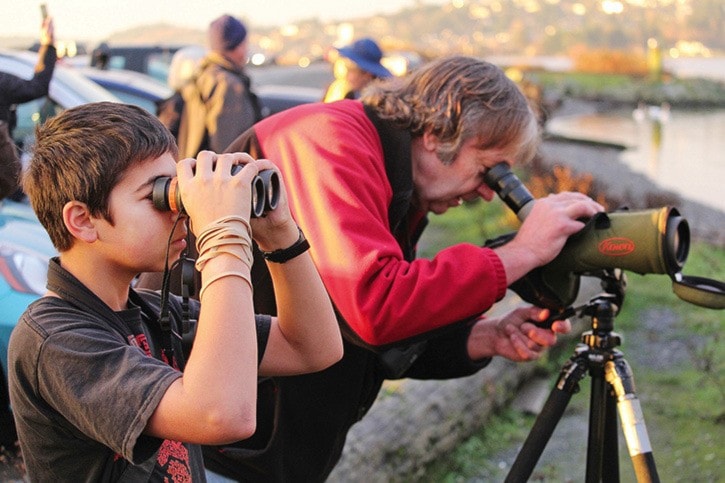For the ultimate birding experience in Victoria, look no further than the waters, shoals and trees of Esquimalt Lagoon.
With a huge variety of habitats, even the most novice of avian enthusiasts will be able to spot fantastic feathered specimens.
“You’re going from ocean to wetlands, to fields, to forests, and that diversity is a big factor in attracting birds,” said Ann Nightingale, a member of the Victoria Natural History Society.
She often takes groups of nature and bird lovers on walks at the Lagoon, and said they “routinely come up with more than 70 species of birds just in one morning.”
More than just sightings of fowl sitting primly in trees or on the sand, the lagoon’s long-time sanctuary status means local and migratory species no longer necessarily view their two-legged visitors as a threat.
“The lagoon is just really great for seeing behaviour,” said fellow society member James Clowater. “You get a lot of birds used to having humans around, and the other thing is there’s a hell of an opportunity to get close.”
A prime example, he said, are the recent sightings of Caspian terns, a striking white bird with black caps and brilliant orange bills. After their colonies were dislocated south of the border, they’ve started migrating up to Canadian waters in the last few years.
“These birds are very acrobatic,” Clowater said, noting that male terns engage in full mating displays at the lagoon. They dive for fish and present their catches to the females, putting on quite the show in the process.
Clowater has also seen a pair of bald eagles co-ordinate the hunt of a very lucky duck that managed to escape, and a Peregrine falcon launch itself at a group of shore birds, who weren’t all quite as fortunate.
“Birders get excited about that kind of behaviour,” he said. “And I think the general public, even if they’re not aware of the specifics, get excited with seeing birds of prey and that kind of scenario. You see more than the birds just sitting there.”
The variety of species is something that most people aren’t aware of, added Nightingale.
“It’s not all about the ducks. There’s a lot of songbirds that use the lagoon too. That’s why the habitat is so important. All that stuff that just looks like brush and weeds to people, it’s fantastic bird habitat.”
Newcomers to the birding world can get overwhelmed with the subtle nuances between species, especially with some of the songbirds, so Clowater suggests joining up with a group that knows what they’re doing.
“For somebody who’s just starting out, the frustration is identification,” he said. “The best and easiest way to learn is to go out with people who know.”
Neighbours or friends with experience can be a wealth of information, or one can go out on a field trip with an organization like the Victoria Natural History Society for expert input.
However one ends up enjoying the spot, the lagoon is not just for the birds, Clowater said. It’s also a prime spot for the public to interact with nature and become more aware of their surroundings, especially kids. “It’s a real gem, and probably the best place around.”
For more information on the Victoria Natural History Society, visit vicnhs.bc.ca.
acowan@goldstreamgazette.com
